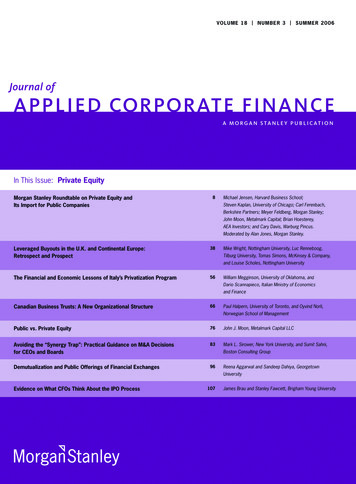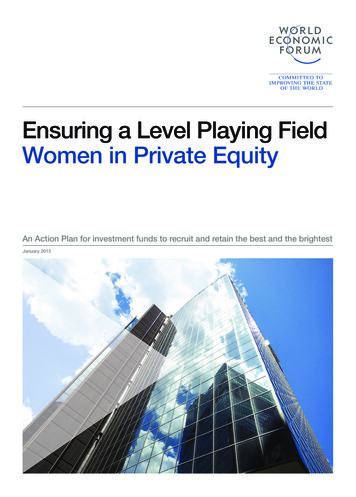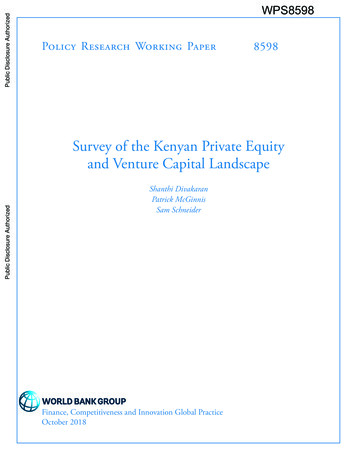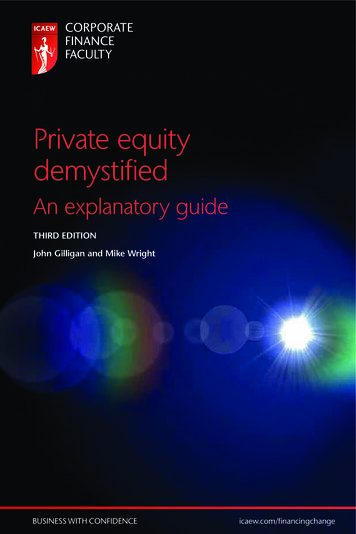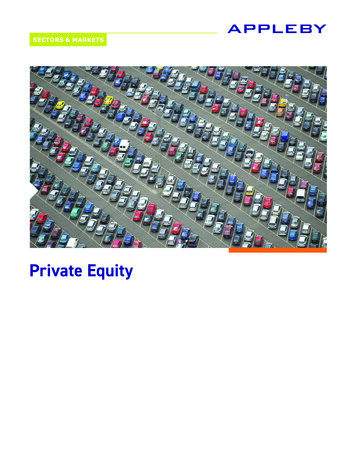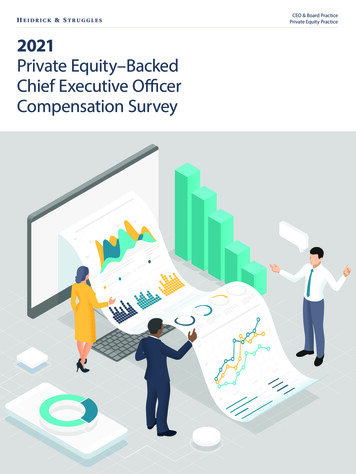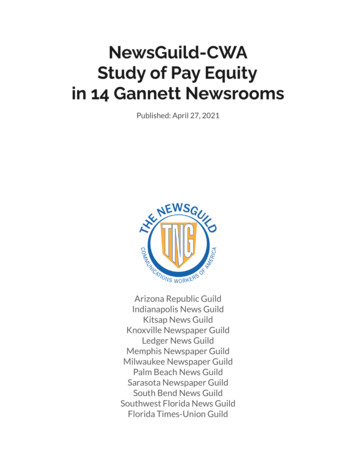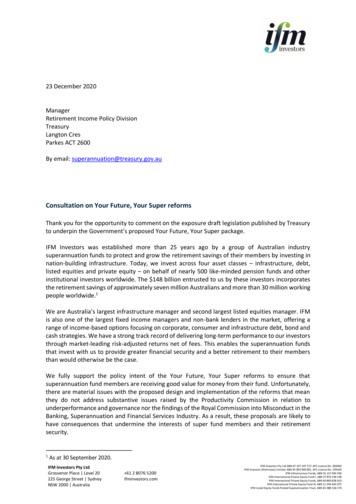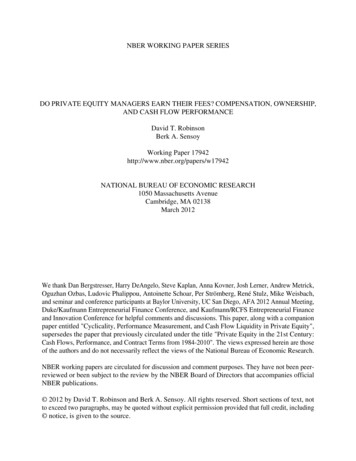
Transcription
NBER WORKING PAPER SERIESDO PRIVATE EQUITY MANAGERS EARN THEIR FEES? COMPENSATION, OWNERSHIP,AND CASH FLOW PERFORMANCEDavid T. RobinsonBerk A. SensoyWorking Paper 17942http://www.nber.org/papers/w17942NATIONAL BUREAU OF ECONOMIC RESEARCH1050 Massachusetts AvenueCambridge, MA 02138March 2012We thank Dan Bergstresser, Harry DeAngelo, Steve Kaplan, Anna Kovner, Josh Lerner, Andrew Metrick,Oguzhan Ozbas, Ludovic Phalippou, Antoinette Schoar, Per Strömberg, René Stulz, Mike Weisbach,and seminar and conference participants at Baylor University, UC San Diego, AFA 2012 Annual Meeting,Duke/Kaufmann Entrepreneurial Finance Conference, and Kaufmann/RCFS Entrepreneurial Financeand Innovation Conference for helpful comments and discussions. This paper, along with a companionpaper entitled "Cyclicality, Performance Measurement, and Cash Flow Liquidity in Private Equity",supersedes the paper that previously circulated under the title "Private Equity in the 21st Century:Cash Flows, Performance, and Contract Terms from 1984-2010". The views expressed herein are thoseof the authors and do not necessarily reflect the views of the National Bureau of Economic Research.NBER working papers are circulated for discussion and comment purposes. They have not been peerreviewed or been subject to the review by the NBER Board of Directors that accompanies officialNBER publications. 2012 by David T. Robinson and Berk A. Sensoy. All rights reserved. Short sections of text, notto exceed two paragraphs, may be quoted without explicit permission provided that full credit, including notice, is given to the source.
Do Private Equity Managers Earn Their Fees? Compensation, Ownership, and Cash FlowPerformanceDavid T. Robinson and Berk A. SensoyNBER Working Paper No. 17942March 2012JEL No. G00,G23,G24,G34ABSTRACTWe study the relation between compensation practices, incentives, and performance in private equityusing new data that connect ownership structures, management contracts, and quarterly cash flowsfor a large sample of buyout and venture capital funds from 1984-2010. Although many critics of privateequity argue that PE firms earn excessive compensation and have muted performance incentives, wefind no evidence that higher compensation or lower managerial ownership are associated with worsenet-of-fee performance, in stark contrast to other asset management settings. Instead, compensationis largely unrelated to net-of-fee cash flow performance. Nevertheless, market conditions during fundraisingare an important driver of compensation, as pay rises and shifts to fixed components during fundraisingbooms. In addition, the behavior of distributions around contractual triggers for fees and carried interestis consistent with an underlying agency conflict between investors and general partners. Our evidenceis most consistent with an equilibrium in which compensation terms reflect agency concerns and theproductivity of manager skills, and in which managers with higher compensation earn back their payby delivering higher gross performance.David T. RobinsonFuqua School of BusinessDuke University100 Fuqua DriveDurham, NC 27708and NBERdavidr@duke.eduBerk A. SensoyOhio State University2100 Neil Ave.Columbus, OH 43210sensoy 4@fisher.osu.edu
I.IntroductionIn private equity, the agency relationship between fund managers (the general partners,or GPs) and investors (the limited partners, or LPs) is governed by a management contractsigned at the inception of the fund. This contract specifies the compensation of the GPs andthe GPs’ own investment in the fund. Because private equity involves long-term financialcommitments from LPs (funds typically last 10 to 13 years), and because LPs have limitedrecourse to alternative governance mechanisms, understanding how the incentives providedby these contracts affect fund performance and GP behavior is a critical question in privateequity, and is important for our understanding of delegated asset management more generally.As private equity has grown in prominence, the industry’s compensation practices andincentive structures have come under increasing scrutiny by industry observers and limitedpartners alike. Critics argue that the typical private equity contract allows GPs to earnexcessive compensation and does too little to discipline GPs or provide them with incentivesto maximize LP returns. For example, Phalippou (2009) argues that the confusing nature ofmanagement contracts allows GPs to charge high fees for low average performance. Othershave argued that excessive fees dampen managers incentives to deliver good performance.1Concerns about such excesses are particularly acute in boom fundraising periods and amonglarge funds. The fact that private equity contractual arrangements and performance aretypically shielded from public disclosures not only adds fuel to these claims, but also makesthem inherently difficult to evaluate.In this paper, we use a novel dataset of 837 buyout and venture capital (VC) private equityfunds from 1984-2010 to study the relations between contracting terms and performance andcash flow behavior in private equity. The data include information on the fixed managementfees and performance-based carried interest that the GP earns as compensation, as well asthe GP’s own investment in the fund, which determines their ownership stake. The dataalso contain the complete sequence of cash flows between LPs and GPs, which we use toconstruct detailed relative performance measures and to examine cash flow behavior directly.The dataset is the first available in the literature to combine information on management1See, for example, “Private Equity Firms Reap Big Fees, Report Says”, New York Times DealBook,November 1, 2010.1
contract terms with fund cash flows.We begin by offering new descriptive evidence on GP compensation and ownership terms.This part of our analysis enhances the picture of private equity compensation previouslypainted in work by Metrick and Yasuda (2010a) and Gompers and Lerner (1999). Thetypical fund follows a “2/20/1” rule: 2% management fee, 20% carried interest, and 1%GP ownership. At the same time, there is substantial variation in terms, both in the crosssection and over time. Our results indicate that during boom periods in private equity, whenfund sizes grow, overall pay goes up (even as a fraction of fund size) and shifts towards fixedcompensation (fees) and away from variable compensation (carry).By itself, this finding is consistent with the idea that compensation practices in boomperiods undermine the incentives of GPs to deliver good performance. Yet, the real questionis whether performance suffers as a result of these practices. We find no evidence that fundswith higher fixed management fees underperform net of fees. This basic result is robust to avariety of controls and performance measures and is unlikely to be driven by differences insystematic risk. This result also holds true among high-fee funds raised in boom fundraisingperiods, as well as funds that are both large in size and have high fractional fees.This result means that, relative to lower fee funds, more expensive private equity fundsearn sufficiently higher gross returns to offset their higher fees. This pattern stands instriking contrast to results in the mutual fund literature, which finds a strong negativerelation between mutual fund fees and net-of-fee performance (e.g. Carhart, 1997; Famaand French, 2010), consistent with the relative lack of sophistication of retail mutual fundinvestors (Berk and van Binsbergen, 2011).We find no evidence that funds with low GP ownership underperform, despite concernsthat managers of such funds are insufficiently bonded to the fund. In fact, for buyout fundsthe opposite is true: low-ownership buyout funds outperform. This is consistent with theview that high-ability GPs prefer to diversify their personal portfolios.Turning to carried interest, despite the limited variation in carried interest in the data,we find some evidence that buyout funds with high carried interest outperform, which iscontrary to the view that high carried interest is excessive. On the other hand, we find thathigh-carry venture capital funds underperform. While this result is weak overall, it grows2
stronger in fundraising booms and among large VC funds, and suggests that carried interestin VC funds is sometimes excessive.Overall, the data offer little support for the view that private equity management contracts allow GPs to charge excessive compensation for the performance they deliver or tohold ownership stakes that are too low to provide adequate incentives to deliver good performance. (The exception is the results on VC carried interest.) Instead, the evidence ismost consistent with the alternative view that limited partners are relatively sophisticatedinvestors who understand the long-term nature of private equity investments and the limitedopportunities for alternative governance mechanisms. Under this alternative view, compensation and ownership terms reflect GP skill, agency concerns, and the demand for GP servicesover time, with higher compensation justified by greater ability to generate gross-of-fee returns. Further, consistent with a Berk and Green (2004)-type equilibrium, the evidence isconsistent with higher-ability GPs largely (but not exclusively) capturing the excess returnsthey generate. In short, GP compensation and ownership practices in private equity are notso distorted that LP returns are compromised.Of course, these findings by no means indicate that agency tensions between GPs andLPs do not exist or cannot be observed in the data. Agency conflicts exist largely becauseGPs possess private information about both the underlying quality of their investments ata particular point in time, as well as their ability to exit the investments over a given timeframe at a particular price. This information asymmetry allows GPs to potentially gamethe timing of exit decisions to exploit contractual provisions that are designed to protect theLP’s return.Accordingly, in the final part of the paper we investigate the behavior induced by thefiner-grained incentives embedded in two such contractual provisions. The typical management contract calls for GPs to first return to LPs all contributed capital (including that formanagement fees), plus in the case of buyout funds an 8% preferred return, before carriedinterest is earned. This “waterfall” has the clearly desirable effect, from LPs’ perspective, ofallowing them to receive “their money back” before GPs earn any profit-sharing. Yet theseprovisions also create an incentive for the GP to time distributions so that they cluster atand just after the waterfall date. By doing so, the GP earns immediate carried interest on3
those distributions, and avoids the risk that the investments might later decline in value.The problem is that this behavior will lead some investments to be harvested too early, whendelaying would have generated more value for LPs. Consistent with these concerns, we findthat distributions cluster around the waterfall date. Such clustering is difficult to rationalizeas an innocuous response to changes in exit opportunities, because there is no reason – otherthan the GP’s particular incentives – why the attractiveness of an exit would spike aroundwaterfall dates.We find further evidence of the underlying agency problem between LPs and GPs when weexamine the impact of the terms upon which GPs earn their management fees on distributionbehavior. In about a third of funds, the basis of the management fee shifts to net investedcapital (cost basis of all investments less cost basis of realized investments) during the fundslife (usually after 4-5 years). While the goal of such a contractual provision is to lowerthe expenses that LPs pay, it also creates the incentive for GPs to hold on to living dead orzombie investments rather than liquidate them and distribute the (modest) proceeds in orderto continue earning management fees on the capital invested.2 We find evidence consistentwith this concern. Funds whose fee basis changes from committed capital to net investedcapital are indeed more likely to exit investments later in the funds life.The findings in this paper contribute to several branches of the literature on private equityand delegated asset management. Our work links the branch of the private equity literaturethat studies aspects of management contracts with that studying cash flow performance.The former literature includes Metrick and Yasuda (2010a), Gompers and Lerner (1999),and Litvak (2009). The latter literature includes Kaplan and Schoar (2005), Phalippou andGottschalg (2009), Ljungqvist, Richardson, and Wolfenzon (2007), Jones and Rhodes-Kropf(2003), and more recently Robinson and Sensoy (2011) and Harris, Jenkinson, and Kaplan(2011). DaRin, Hellmann, and Puri (2011) and Metrick and Yasuda (2011) survey the privateequity literature.Our work also adds to the literature studying compensation, ownership, and their link toperformance in other delegated asset management settings, notably mutual funds and hedgefunds. As noted above, several studies find a negative relation between mutual fund fees and2See for example “Private Equity Trapped in ‘Zombie Funds’”, The Financial Times, December 11, 2011.4
net-of-fee returns. Busse, Goyal, and Wahal (2010) find that institutional investment portfolios come much closer to earning back their fees on average than do mutual funds. Khorana,Servaes, and Wedge (2007) find that mutual fund manager ownership is positively associatedwith performance. Agrawal, Daniel, and Naik (2009) find that hedge fund managers withstronger incentive compensation and higher ownership earn higher net returns, suggestingthat hedge fund managers do not capture excess returns in the form of higher compensationto the same extent that is true in private equity.This paper proceeds as follows. Section II presents the data. Section III studies thedeterminants of compensation and ownership terms, both across funds and over time. SectionIV relates these terms to the cash flow performance of the funds. Section V studies agencyissues involving distribution behavior. Section VI concludes.II.A.Data and Sample ConstructionCoverage, Variables, and Sample SelectionOur analysis uses a confidential, proprietary dataset obtained from a large, institutionallimited partner with extensive investments in private equity. Table 1 reports that there are837 buyout and venture capital funds in our sample, representing almost 600 billion incommitted capital spanning vintage years 1984-2009. The sample comprises a significantfraction of the documented universe of private equity. We have 34.4% of the Venture Economics (VE) universe of total capital committed to U.S. venture capital and buyout funds,and 55.7% of that committed to U.S. buyout funds, over the same time period.3For each fund, the data contain fund-level information on the management fees andcarried interest that the GPs earn as compensation, as well as the GPs’ own investment(capital commitment) in the fund. The GP’s capital commitment determines their directownership stake in the fund. The data also contain the complete quarterly cash flows (capitalcalls and distributions) to and from the funds and their limited partners, as well as quarterlyestimated (by the GP) market values of unrealized investments. The cash flows are net of3We have about 80% as many U.S. buyout funds in our data as the number for which VE, Preqin, andCambridge Associates report (only) fund-level IRRs.5
all management fees and carried interest, and comprise over 41,000 time-series observationsextending through the second quarter of 2010. We also have data on fund size and oneach fund’s position in its partnership’s sequence of funds (sequence number), and we knowwhether any two funds belong to the same partnership.4 The data were anonymized beforethey were provided to us so we do not know the identity of the GPs or the names of thefunds.The dataset comprises the largest and most recent sample of private equity compensationterms in the literature, and is the first available for academic research to include informationon GP ownership. Critically for our purpose, the dataset is also the first to combine cashflow information with compensation and ownership data. Another important advantage ofthe data is that they come directly from the LP’s internal accounting system, and so are freefrom the reporting and survivorship biases that plague commercially available private equitydatabases (Harris, Jenkinson, and Stucke, 2010). The data are also at least partially random:the data provider’s overall private equity portfolio was assembled over time through a seriesof mergers that occurred for reasons unrelated to each company’s private equity portfolio.While our data have many advantages, they do not cover all aspects of the managementcontracts. In particular, we lack information on the specific carry timing rules for a givenfund, and on the split of portfolio company transaction and monitoring fees between GPsand LPs (the latter is relevant only for buyout funds). In principle, this has the potentialto create measurement error problems for our analysis. However, as we discuss in SectionIV.C, these provisions are likely uncorrelated with the variables we include in our analysis.Thus, these omitted contractual provisions are unlikely to bias our conclusions.5Because our data come from a single (albeit large) limited partner, the representativeness of the sample is a natural concern. Robinson and Sensoy (2011) compare the data tocommercially available databases (VE, Preqin, and Cambridge Associates). They note thatassessing representativeness is difficult because the universe of private equity funds is unavailable and because commercial databases provide inconsistent accounts of private equity4All 837 funds are bona fide funds. There are no side-car or co-investment vehicles in our data.We also do not observe the side agreements between different investors and the GPs of the funds inquestion. Repeated conversations with our data provider and with other industry practitioners indicate thatthis does not obscure our ability to understand what the real fees are: Moreover, side letters are made publicto all the investors in the fund through “most favored nation” clauses.56
performance (Metrick and Yasuda, 2010b; Harris, Jenkinson, and Stucke, 2010). In addition,commercial databases include neither compensation/ownership data nor cash flow data, andso are unsuitable for our purpose in any case. Robinson and Sensoy (2011) find no evidencethat the performance (IRR) of buyout funds in our sample differs significantly from thatreported by commercial databases. Venture capital IRRs in our data are somewhat belowwhat is reported in commercial databases. However, Lerner, Schoar, and Wongsunwai (2007)show that the best-performing VC funds are concentrated among one particular class of LP(endowments), who seem to have superior access to funds. Thus the differences for venturecapital likely reflect the GP/LP matching process more than a selection bias per se, with oursample likely representative of funds to which the typical VC investor has access. Moreover,our cross-sectional analyses are only sensitive to selection issues insofar as any potential biasin the data is correlated in specific ways with the explanatory variables. In any case, ourresults should be interpreted bearing in mind the caveat that we do not have the universe ofprivate equity funds.B.Summary Statistics on Fund CharacteristicsThe characteristics of our sample funds are presented in Table 1. As noted above, the837 funds in our sample represent almost 600 billion in committed capital. This figure is26.5% of the total capitalization of the VE universe of the same fund types over the 19842009 vintage year time frame. Restricting attention to U.S. funds only, we have 34.4% ofthe total capitalization of the U.S. private equity universe covered by VE. Coverage variessignificantly by fund type. Our data include 295 venture capital funds representing 61.4billion in committed venture capital, or around 16% of the VE universe of U.S. venture funds.We have 542 buyout funds, for a total committed capital of 535.5 billion, representing 55.7%of the total capitalization of the VE U.S. buyout universe. On average, 35% of our funds arefirst funds. 23% are second funds raised by a firm, and 15% of the funds are third-sequencefunds. These numbers are similar to those for the sample used by Kaplan and Schoar (2005).The average (median) fund size is 208 million ( 106 million) for venture capital funds and 988 million ( 313 million) for buyout funds.Because many of the funds in our sample have recent vintage years and are still active, we7
also present summary statistics for the sample of funds that were either officially liquidatedas of 6/30/2010, or had no cash flow activity for the last six quarters of the sample and hadvintage years prior to 2006. This is called the “Liquidated Sample”, and has the advantagethat performance in this sample is largely based on actual cash flows and not potentiallysubjective market values of unrealized investments. The liquidated sample includes abouttwo-thirds of all funds in the total sample, and represents about half of the total committedcapital in the full sample. The composition of first, second and third funds is roughlyequivalent across the full sample and the liquidated sample. The mean fund size is smallerby some 160 million in the liquidated sample, reflecting the growing prevalence of largebuyout funds in the post-2006 vintage portion of the sample.C.Summary Statistics on General Partner Compensation and OwnershipTable 2 provides summary statistics on GP compensation terms (fixed management feesand performance-sensitive carried interest) and on their own capital commitments to thefunds they manage, which in turn determine their ownership stakes in the funds. Theseterms are all contracted at the beginning of a fund’s life, and are not renegotiated during thelife of the fund. Summary statistics on these terms are useful in their own right because noprior work has had access to data on GP ownership, and because our sample of compensationterms is both larger and more recent than Gompers and Lerner (1999) and Metrick andYasuda (2010a).C.1.Management feesPanel A presents statistics for the full sample, beginning with management fees. For 82of our 837 funds, management fees are either unknown or are subject to yearly negotiationrather than being specified in advance. We exclude these funds from the fee statistics andanalyses, as do Gompers and Lerner (1999).In the management contract, management fees are expressed as a fee percentage and abasis to which the percentage applies. As Panel A of Table 2 shows, almost all funds (92%)have an initial fee basis of committed capital (i.e., fund size, which is fixed for the life ofthe fund). The initial percentage fee (the percentage in effect for the first year of the fund’s8
life) is usually in the range of 1.5% to 2.5%. The average (median) initial fee for VC fundsis 2.24% (2.50%), while the figures for buyout funds are lower, at 1.78% for the mean and2.00% for the median.The contract frequently stipulates that the fee percentage and/or basis changes at somepoint during the life of the fund. These changes almost uniformly result in lower managementfees later in the fund’s life. Panel A of Table 2 shows that 45% of funds see their fee percentagechange at least once, while 33% have a change in basis.6 59% of funds have one type of changeor the other (or both), while 18% have both. Venture capital funds are more likely to havethe fee percentage change compared to buyout (55% compared to 38% of funds), while theopposite is true for fee basis changes (12% of VC funds have their fee basis change, comparedto 41% of buyout funds).Changing fee percentages and bases imply that it is not sufficient to simply comparemanagement fees across funds solely on the basis of their initial fee percentages and bases.Instead, to conduct an apples-to-apples comparison, we use the fee basis and percentageinformation to forecast the expected (at fund inception) dollar management fee for each yearof the fund’s expected life (assumed to be 10 years for all funds). We then calculate eachfund’s “lifetime fees”, defined as the undiscounted sum of the expected annual fees. Wealso calculate the present value (at fund inception) of these lifetime fees by discounting eachexpected annual fee using the 10-year Treasury bond rate in effect at the fund’s inception(“PV lifetime fees”).7 These calculations follow Metrick and Yasuda (2010a), and details areprovided in the Appendix.Panel A of Table 2 displays summary statistics for lifetime fees and their present value,expressed as a percentage of committed capital. The average (median) lifetime fee is 20.37%(21.38%) of committed capital for VC funds, and 14.49% (14.23%) for buyout funds. Thepresent value of the lifetime fee is on average (median) 16.01% (16.69%) of committed capital for VC funds, and 11.65% (11.52%) for buyout funds. For both types of funds, fixedmanagement fees are a substantial fraction of the total capital committed by LPs. More6The most common basis change is to “net invested capital”, defined as the total (equity) capital investedin portfolio companies to date minus the (equity) cost basis of all realized investments. The change to netinvested capital has the effect that fees are earned only on active, and not on realized, investments.7We choose the risk-free rate over the contracted life of the fund as the discount rate because managementfees are a contractual obligation over this horizon.9
over, consistent with the initial fee percentage, buyout fund fees are a significantly smallerpercentage of fund size than venture capital fund fees. However, dollar fees are on averagehigher in buyout funds because of their greater size.Panel B of Table 2 displays the same summary statistics for the sample of liquidatedfunds. These statistics are similar to those in Panel A.Overall, while the median initial fee percentage is indeed 2%, consistent with the “2 and20” conventional wisdom, there is a substantial amount of variation in management fee termsand expected values, both across and within fund classes.C.2.Carried InterestPanel A of Table 2 also shows summary statistics for the carried interest (or carry) of thefull sample of funds. The carry specifies the GP’s share of the profits earned by the fund.Consistent with prior work, a carried interest of 20% is the norm, obtained by 89% of VCfunds and 97% of buyout funds. 1% of VC funds and 2% of buyout funds have carry below20%. 10% of VC funds and 1% of buyout funds have carry above 20%. The average carriedinterest is 20.44% for VC funds and 19.96% for buyout funds. Thus, the median fund in oursample has the conventional wisdom “2 and 20” management fee and carried interest. Thereis considerably less variation in carried interest than in management fees. What variationdoes exist is largely in venture funds, and to a lesser extent in buyout funds. This patternis consistent with Metrick and Yasuda (2010a), though our sample displays some variationacross buyout funds while theirs does not. Panel B of Table 2 shows summary statistics forcarried interest for the sample of liquidated funds, which are similar to those in Panel A.C.3.General Partner OwnershipFinally, Panel A of Table 2 shows summary statistics for the capital commitments ofthe general partners to their funds. The GP’s capital commitment determines its ownershipstake in the fund, and our data are based on the actual GP commitment.The median GP capital commitment is 1% of fund size, resulting in a 1% ownershipstake. 56% of VC funds and 35% of buyout funds have a GP ownership between 0.99%and 1.01%. The average GP ownership is 1.78% for VC funds and a significantly higher10
2.38% for buyout funds. 26% (18%) of VC funds and 43% (23%) of buyout funds have GPownership stakes above 1.01% (below 0.99%). Though not reported in the table, the factthat buyout funds are substantially larger than VC funds on average causes the differencein GP ownership to be greatly amplified in dollar terms.Overall, these facts indicate that while it is in some sense standard for general partnersto post 1% of total committed capital, a significant fraction of GPs invest smaller or largerstakes in their funds, particularly in buyout funds. Moreover, buyout GPs have higherownership, in both percentage and dollar terms, than VC GPs. For both types of funds,there is considerably more variation in ownership stakes than in carried interest.III.The Determinants of General Partner Compensation andOwnershipIn this section, we analyze the determinants of general partner management fees, carriedinterest, and ownership terms. We relate these contractual terms to market conditions andother observable fund characteristics at the time a fund is raised.Despite the oft-stated concerns about excessive fees in boom periods, no prior work analyzes how compensation terms vary over fundraising cycles. To this end, a key explanatoryvariable in our analysis is “ln (Industry Flows)”, which measures the natural logarithm of thetotal market-wide committed capital to the fund’s asset class (buyout or VC) in the fund’svintage year. In other words, “Industry Flows” is the total fundraising by all funds of thesame type and same vintage year as the focal fund. We construct this measure using datafrom Venture Economics, and not our own sample funds, to capture market-wide fundraisingactivity.We employ fund size and sequence number as additional explanatory variables. Gompersand Lerner (1999), analyzing a sample of venture capital funds raised before 1992, find thatlarger and older funds have
1See, for example, \Private Equity Firms Reap Big Fees, Report Says", New York Times DealBook, November 1, 2010. 1. contract terms with fund cash ows. We begin by o ering new descriptive evidence on GP compensation and ownership terms. This part of our analysis enhances the picture of private equity compensation previously
